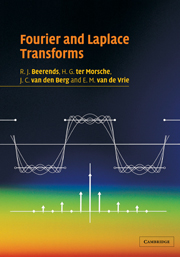Book contents
- Frontmatter
- Contents
- Preface
- Introduction
- Part 1 Applications and foundations
- Part 2 Fourier series
- 3 Fourier series: definition and properties
- 4 The fundamental theorem of Fourier series
- 5 Applications of Fourier series
- Part 3 Fourier integrals and distributions
- Part 4 Laplace transforms
- Part 5 Discrete transforms
- Literature
- Tables of transforms and properties
- Index
3 - Fourier series: definition and properties
Published online by Cambridge University Press: 05 June 2012
- Frontmatter
- Contents
- Preface
- Introduction
- Part 1 Applications and foundations
- Part 2 Fourier series
- 3 Fourier series: definition and properties
- 4 The fundamental theorem of Fourier series
- 5 Applications of Fourier series
- Part 3 Fourier integrals and distributions
- Part 4 Laplace transforms
- Part 5 Discrete transforms
- Literature
- Tables of transforms and properties
- Index
Summary
INTRODUCTION
Many phenomena in the applications of the natural and engineering sciences are periodic in nature. Examples are the vibrations of strings, springs and other objects, rotating parts in machines, the movement of the planets around the sun, the tides of the sea, the movement of a pendulum in a clock, the voltages and currents in electrical networks, electromagnetic signals emitted by transmittters in satellites, light signals transmitted through glassfibers, etc. Seemingly, all these systems operate in complicated ways; the phenomena that can be observed often behave in an erratic way. In many cases, however, they do show some kind of repetition. In order to analyse these systems, one can make use of elementary periodic functions or signals from mathematics, the sine and cosine functions. For many systems, the response or behaviour can be completely calculated or measured, by exposing them to influences or inputs given by these elementary functions. When, moreover, these systems are linear, then one can also calculate the response to a linear combination of such influences, since this will result in the same linear combination of responses.
Hence, for the study of the aforementioned phenomena, two matters are of importance.
On the one hand one should look at how systems behave under influences that can be described by elementary mathematical functions. Such an analysis will in general require specific knowledge of the system being studied.
- Type
- Chapter
- Information
- Fourier and Laplace Transforms , pp. 60 - 85Publisher: Cambridge University PressPrint publication year: 2003



